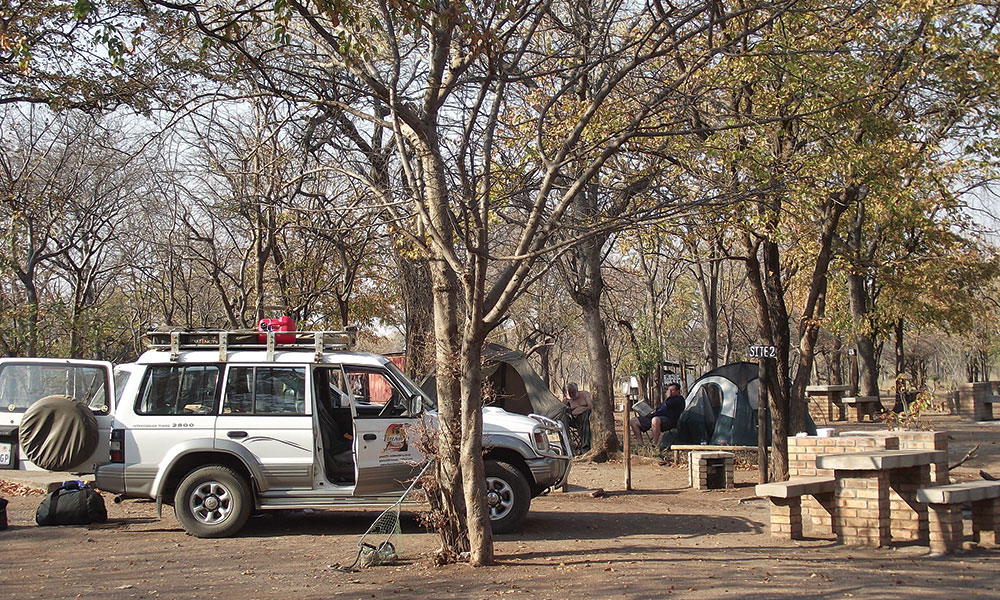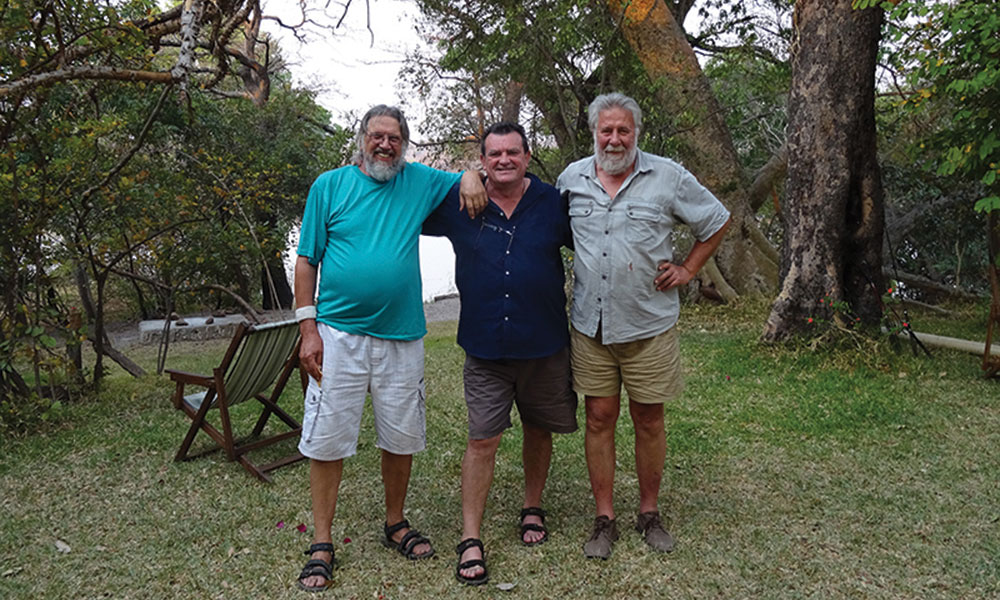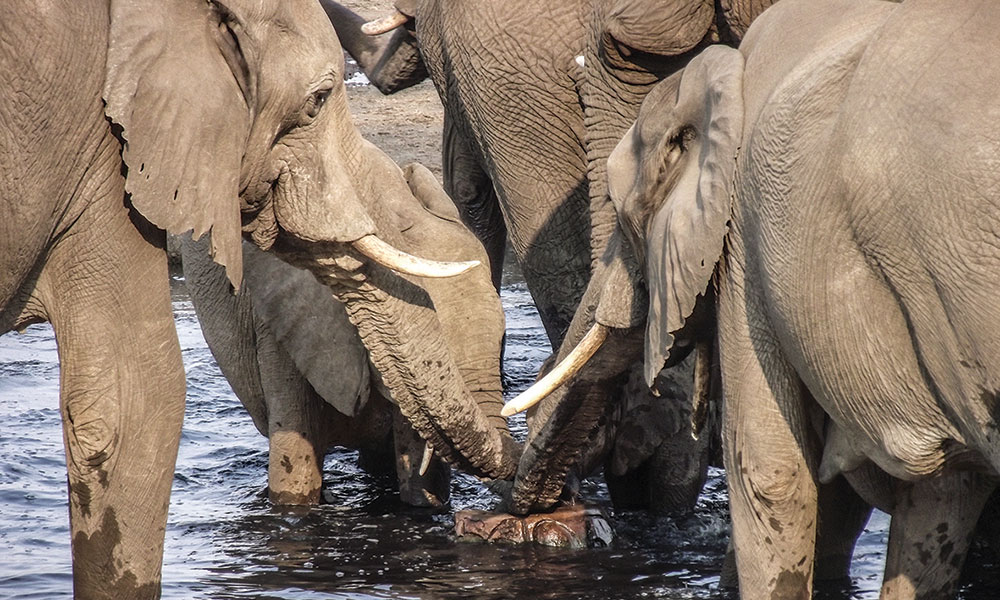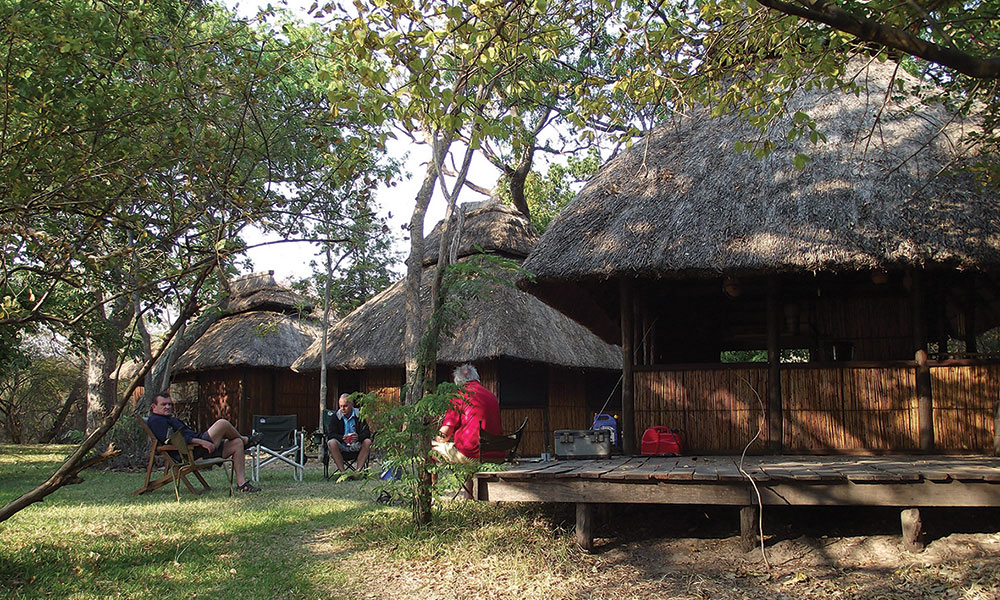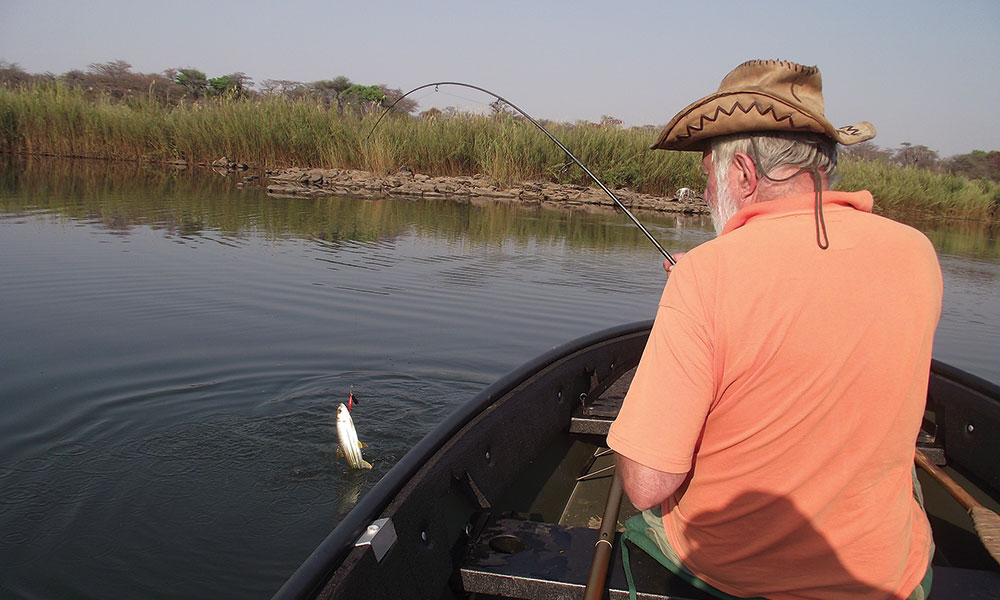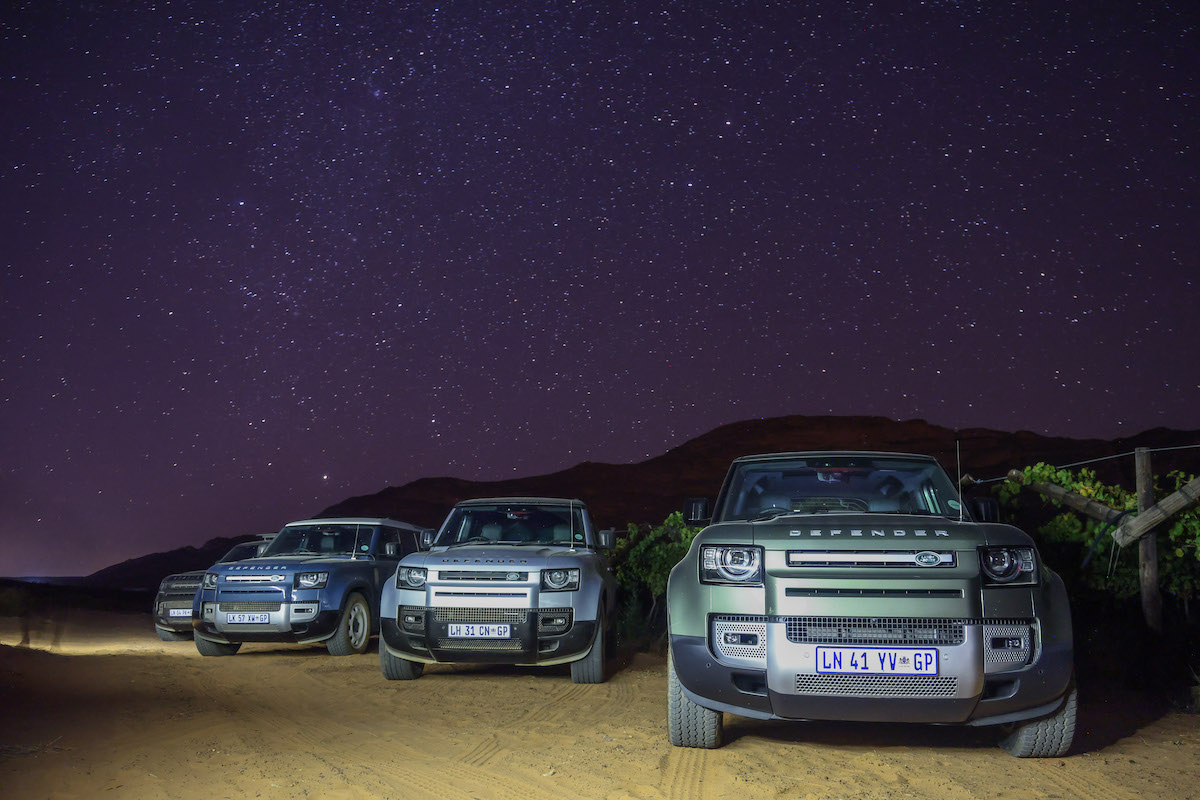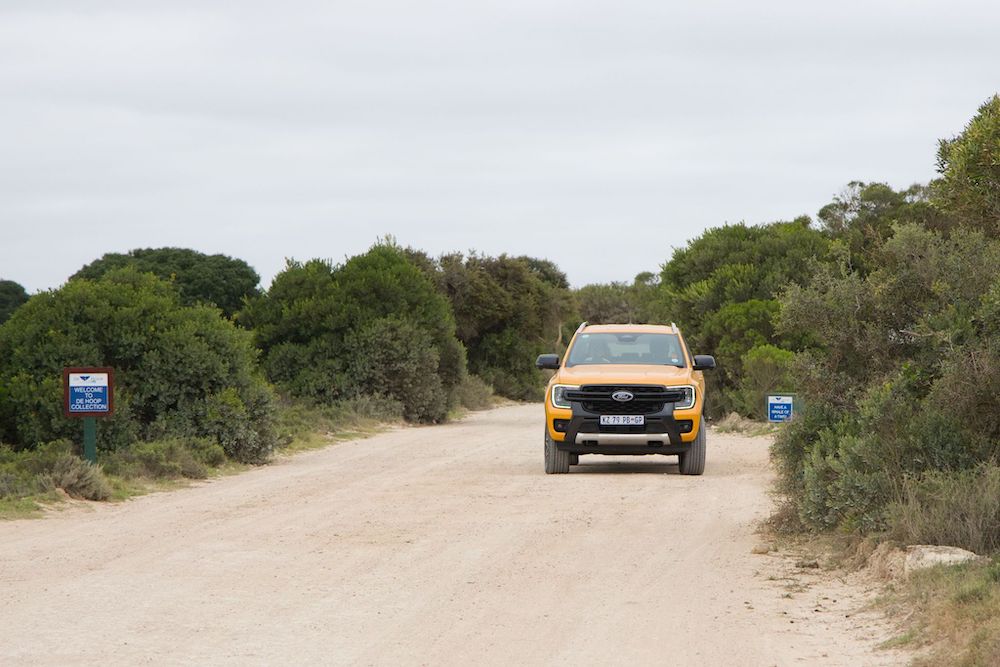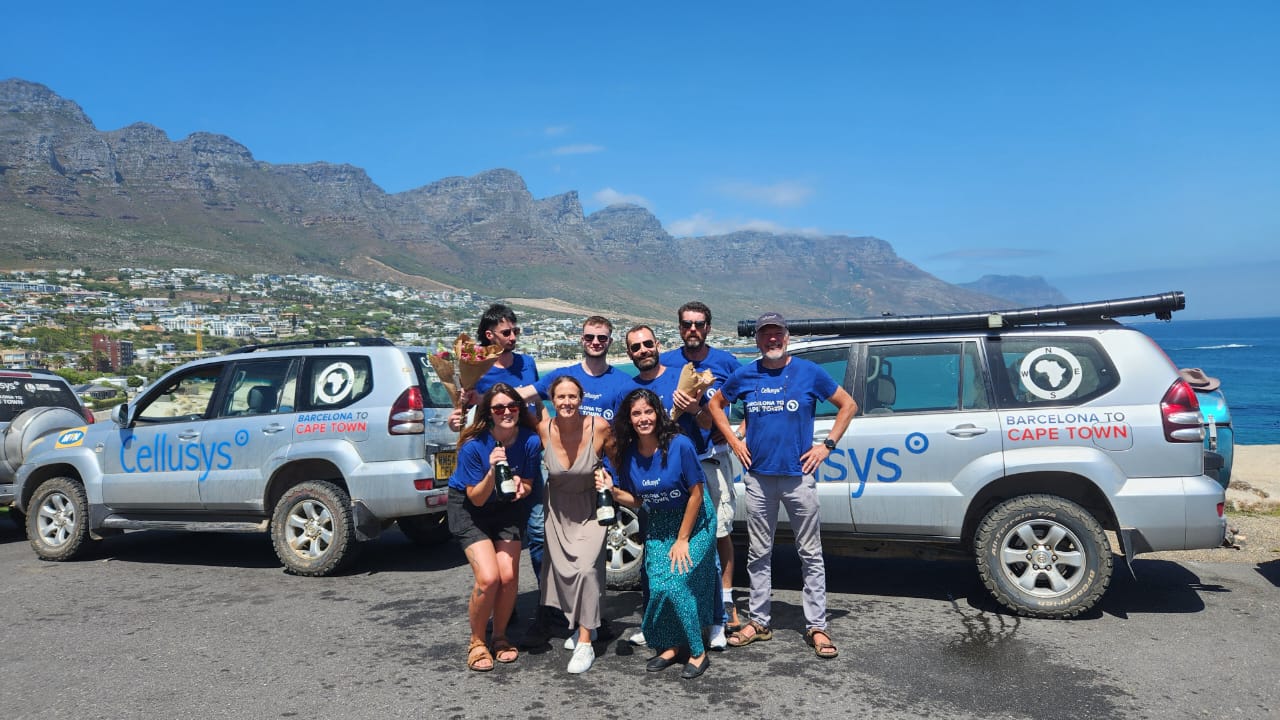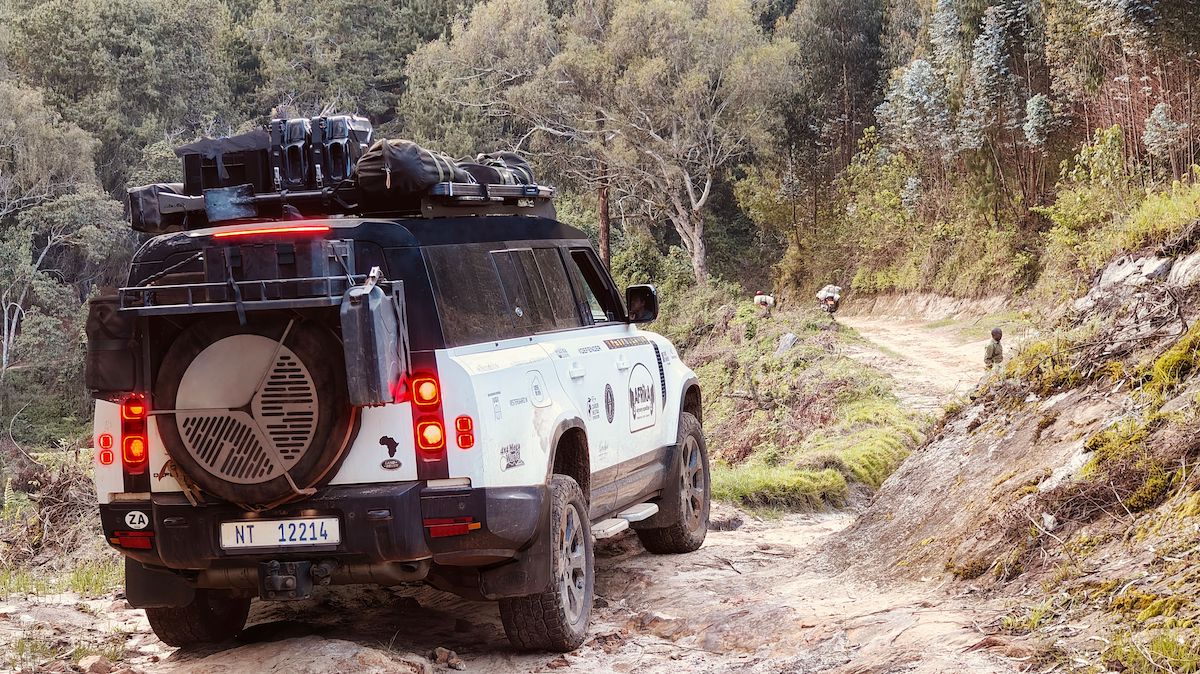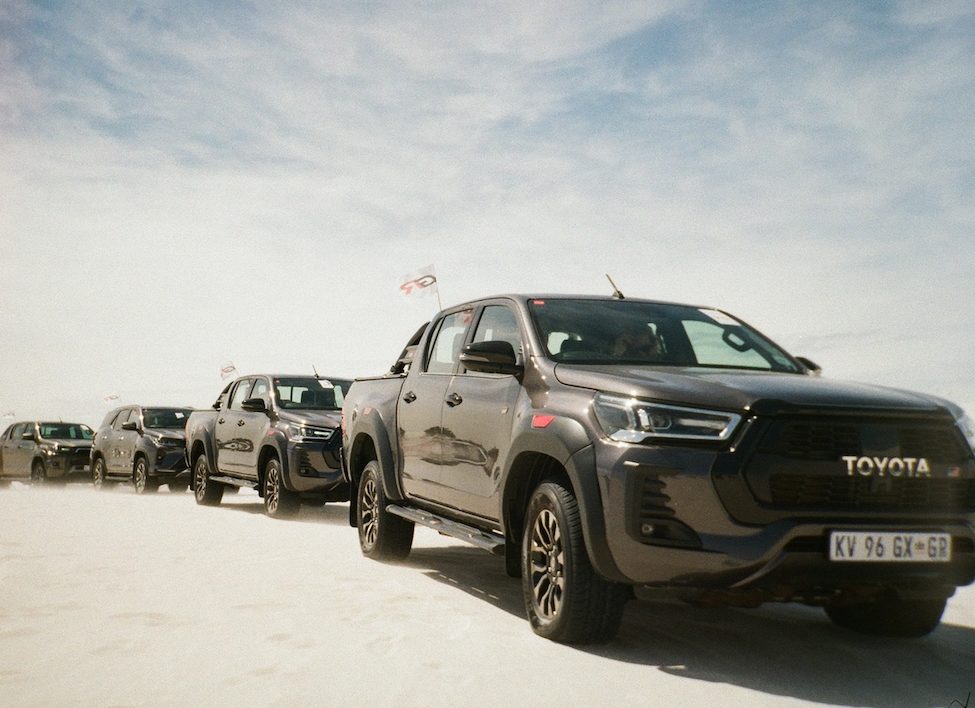A fisherman’s truthful tale
From a night at the Oasis Lodge that he would rather forget, to nine blissful days lolling about on the Zambezi, Paul van Pletzen lets us in on his trip to Zambia, shy fish and unusual folding boats.
Our trip to the upper Zambezi in September originated in an unusual manner. While I was researching a small, light- weight folding boat that can be carried on a car’s roof racks, I made friends, via the internet, with the Southern African franchise holder who lives in San Diego, California. A number of email exchanges culminated in Pieter, my brother and fellow adventurer, and I being invited to his fishing lodge on the upper Zambezi in Zambia. The lodge, called Kavumbu, has up until now, been used exclusively as a private family retreat, but owners are considering making it available to a few keen fishing groups.
Kavumbu is situated about 80km north of Katima Mulilo and we accepted the invitation to test this concept with enthusiasm, having previously had some memorable fishing trips on various parts of the Zambezi. Because of the relative remoteness of this part of the river, the few fishing lodges this far north are usually fly-in and hellish expensive, so the idea of fishing at an accessible self-drive, self-catering and very affordable facility had immediate appeal. The owner makes exclusive use of portable, lightweight Porta Botes at the lodge, as they can be launched easily at any access point along a river. We were given the opportunity to use them, too.
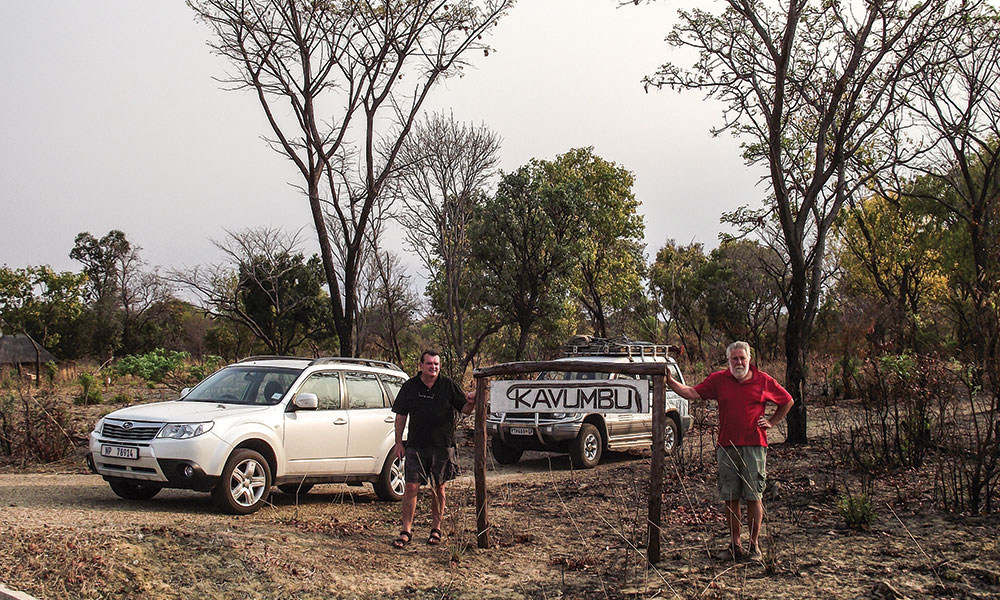 Gerhard and Pieter at the entrance to Kavumbu.
Gerhard and Pieter at the entrance to Kavumbu.
A friend of ours, Gerard Ronan, joined us at the last minute and came along in his own car. Hoping for a quick and easy border crossing, we left Johannesburg early in the morning and entered Botswana at the Zanzibar border post, just north of Groblersbrug. After what felt like only 20 minutes and minimal paperwork, we were through. We were quite tired and spent the evening at Oasis Lodge near the border post. What a dump! The rondavels are expensive at 400 pula each and we had to pay for two because they only have two beds. They were stuffy, had toilets that were positioned in a way that made them impossible to sit on, and the staff were slow, full of attitude and unhelpful. On top of this, they took pains to remind us of their house rules: no consumption of your own alcohol or food because they have a bar and restaurant. We were the only guests, so all staff (except the barman) went off duty early, so we defied them and ate our padkos and drank our wine and beer on the lawn outside.
That meant that the barman was the only person available to help us when the water tank ran dry, just as we wanted to take a shower. It took an hour for him to locate someone to start the pump. The rondavels were tightly squeezed in between other buildings, and hordes of mosquitoes disturbed our sleep that evening. We left early the next morning, travelling on good tar roads all the way north, refuelling in Nata and staying over at Panda Rest Camp in Pandamatenga. The chalets were fully booked so we had to camp (R240 per site). The newly repaired road north of Pandamatenga was already beginning to show signs of degradation, with some potholes. We refuelled in Kasane and crossed over into the Caprivi Strip at Ngoma, without much hassle. The total border fees at Ngoma amounted to R285 per vehicle. We did all our last-minute shopping for food and drink at Katima Mulilo, which would be the last commercial centre that we would encounter on our way to Kavumbu.
Welcome to Zambia
We crossed over the Namibian side of the border fairly quickly, but entering the Zambian side took about two hours. The officials made the filling in of forms for carbon tax, road tax and various others a tedious process and the money changers ripped us off until we discovered that there was a bank at the border post where money can be exchanged at a much better rate. The border crossing fees into Zambia were the most expensive of the entire trip, amounting to about R900 per vehicle and just when we thought we were done, there was a final District Council community levy of $30 per vehicle due at the exit gate. Travelling 80km on a freshly tarred road, we reached Kavumbu an hour later, arriving in the afternoon.
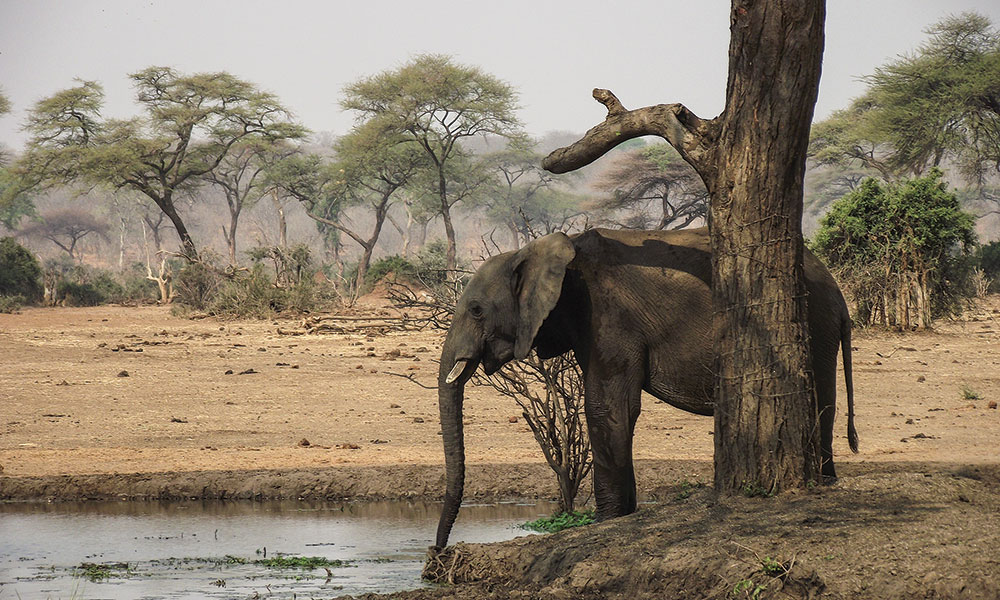 An elephant arrives at Senyati Camp’s beautiful watering hole.
An elephant arrives at Senyati Camp’s beautiful watering hole.
Kavumbu’s simplicity offered more than we had expected. What it lacks in opulence, it more than makes up for in rustic comfort and functionality. The main accommodation is made up of two lodges: one with a double bed and single bed, and the other with two rooms and four single beds. There is a small, fully equipped kitchen with pots, pans, cutlery, gas stove and freezer. Next to the kitchen is a spacious, thatched lapa with tables and bench-seats surrounded by a low wall. There’s also a campsite on a lush green lawn under shady trees, with a neat double ablution block nearby.
All bedding and bath towels are provided for the lodges, and there are two or three friendly staff on hand to service the rooms daily, keep the kitchen clean, take care of all laundry and keep the boats operational. The guest lodges have en suite ablutions with hot and cold running water (toilet and hand basin), although these were in need of some maintenance. We had our morning or evening shower at the nearby campsite ablution, situated under large, indigenous trees. Water is pumped from the river, so you need to boil it or take your own drinking water, while wood-fired donkey geysers provide the hot water. A solar inverter/battery system provides simple but adequate lighting and we supplemented this with our own LED lights in the lapa and kitchen. Late afternoons and evenings were spent relaxing with sundowners on the lawns.
Kavumbu Camp is situated in the Sisheke Chiefdom in the southern part of Barotseland. Although it does not officially fall within the Barotse floodplain, the water levels still rise significantly during the wet season. Unlike most other camps in the region, however, it is still accessible all year. The long-neglected Sioma Ngwezi National Park is situated nearby and the whole area will form part of the Kavango Zambezi Transfrontier Conservation Area (KAZA TFCA), once the treaty if officially signed. This is potentially the world’s largest conservation area, spanning five Southern African countries: Angola, Botswana, Namibia, Zambia and Zimbabwe and centred on the Caprivi-Chobe-Victoria Falls area. Sioma Ngwezi is an almost unheard of tract of completely undeveloped wilderness and it is hoped that its inclusion into KAZA TFCA will help trigger its re-emergence, following the years of neglect and poaching activities during the era of the border conflict between what was the former South West Africa and Zambia.
The well-known Ngonye Falls (sometimes called Sioma Falls) is a short hop north of Kavumbu on the newly tarred road. A new bridge across the Zambezi at Ngonye Falls has obviated the old cumbersome ferry for travellers on their way north to Senanga, Mongu and the Liuwa Plains National Park, which is now within an easy day’s drive from Kavumbu. Kavumbu is comfortable, well-equipped and, most importantly, affordable. At $55 per self-catering guest lodge per night, or $30 per campsite (there are five sites), and $60 per half day for the use of motorboats (15 litres of fuel included), it is an ideal fisherman’s getaway. It is also a birder’s paradise during certain times of the year. To promote the sense of unspoilt exclusivity and private enjoyment of this remote and attractive spot on the river, the campsite will not be available if the guest lodges are occupied and vice versa.
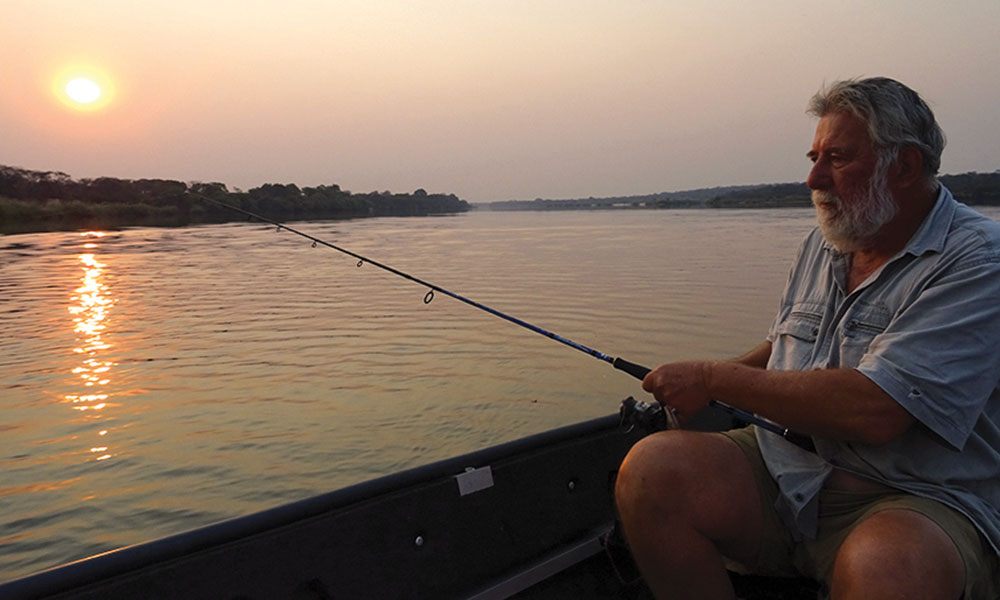 Pieter having a last cast for a tiger fish on the Zambezi at sunset in front of Kavumbu Camp.
Pieter having a last cast for a tiger fish on the Zambezi at sunset in front of Kavumbu Camp.
Something fishy
On our first morning at camp, David, the camp attendant, took Pieter out on one of the Porta-Botes and he had a few good strikes, catching two small tiger fish and losing a whopper. That afternoon I also caught two tigers of around a kilo or so and we thought that prospects were good for lots of fishing fun and tales to take back home. Unfortunately, fishing might have been influenced by the seasonal mass of cicadas in all the trees, as the game fish quickly disappeared… and that was the last of it. For the rest of our time, we flogged the water with an array of jigs, spinner baits, fish fillets, surface lures and rapalas. We tried the deep water, in the currents, by the reeds or the rocks, from the islands, but they were not there. We even had trouble catching small breams for bait. It was very hot during the day, with a persistent stiff breeze that blew the little boats about, the river was quite low and it was full moon; these could all have been influencing factors.
Or maybe we were not spending enough time fishing? We were disappointed, though not unhappy. On our third day a couple of journalist friends of ours from Harare, Ant Williams and his wife Renée, joined us at Kavumbu. Ant is an accomplished tiger fisherman with many years of experience, but even he could not lure or land any fish. An interesting aspect to Kavumbu was its boats. Lightweight, portable and requiring minimal horsepower, they are manufactured from polypropylene, while rigidity is provided by bench seats, the prow and transom. Kavumbu’s two 14-inch boats were powered by a 5.8hp two-stroke and 9.8hp four-stroke outboard engines. If required, the boats are light enough to be dismantled, folded up and loaded onto a roof rack and taken to other parts of the river. We used them only from the camp mooring, though. The boats worked well and are strong and secure, but unfortunately the low and narrow seats cause you to sit in an uncomfortably cramped, almost squatting position, making attachments with backrests essential.
Even a thick cushion will help. Pieter and I became painfully uncomfort-able after an hour or so in a boat. We also did not trust ourselves to stand upright in them, one of the touted advantages of the flexible hulls. The boat can accommodate three people, but then fishing becomes difficult. Our lack of knowledge of the river with its various rocky outcrops and sandbanks – and the nearby resident hippo pods – restricted the distance we travelled, so the availability of a local fishing guide is essential to give you more freedom to fish extensively. We established that fishermen may bring their own boats and self-launch (a 4×4 is necessary) off the bank at the far end of Nambula Pan, near the lodge.
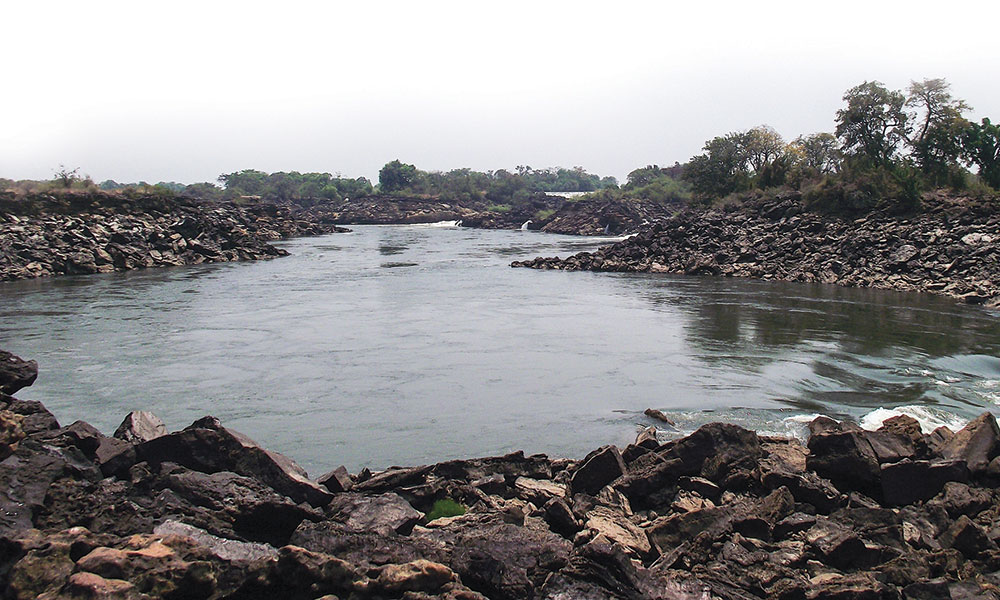 A section of rapids at Ngonye Falls.
A section of rapids at Ngonye Falls.
Homeward-bound
We spent nine days relaxing at Kavumbu, enjoying the adventure, the company and the Zambezi River in this untouched and special place. We were in the company of hippo and for a day or two, had elephant feeding on the ridge just above the camp. Our days passed pleasantly and soon it was time to leave. On our way home, we spent two days camping at Senyati Safari Camp, just off the main road about 10km south of Kazangulu. Senyati is situated along a game migration route, just outside the Chobe Game Reserve, and large herds of elephant, buffalo and many other animals can be viewed from the comfort of the camp’s bar, built right next to a waterhole.
Our last evening en route was spent at Kwa Nokeng Lodge at Martin’s Drift border post in Botswana, where we booked one of the comfortable, self-catering, two-bedroomed houses for about R1 200. Crossing back into South Africa the next morning was quick and easy. We left behind a spot that deserves a lot more time to explore. Lured into the slow pace of the river, we missed the opportunity to camp wild at Katuli Pools in Sioma Ngwezi Park just two hours’ drive from Kavumbu and to visit the Liuwa Plains National Park, about seven hours north. These should be essential side excursions for any trip to this region. As we always say and hope… next time.
Ant Williams is considering organising guided fishing groups to Kavumbu in the future. For more information and bookings, email [email protected] or view the website at http://www.kavumbucamp.com
